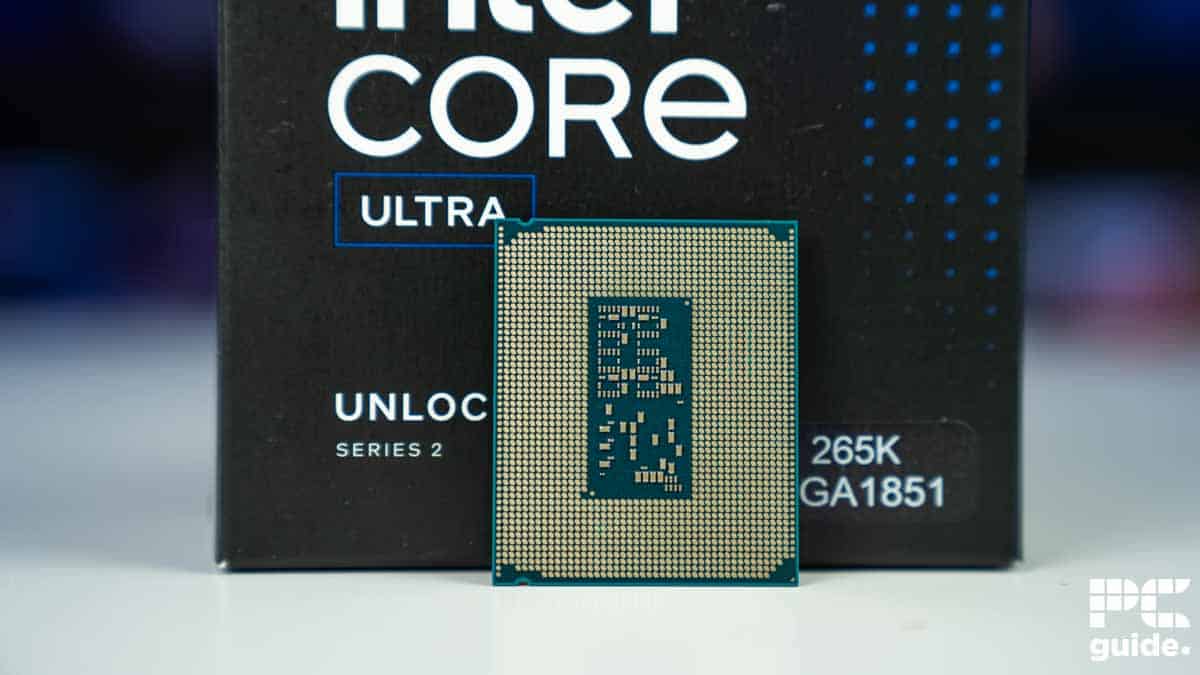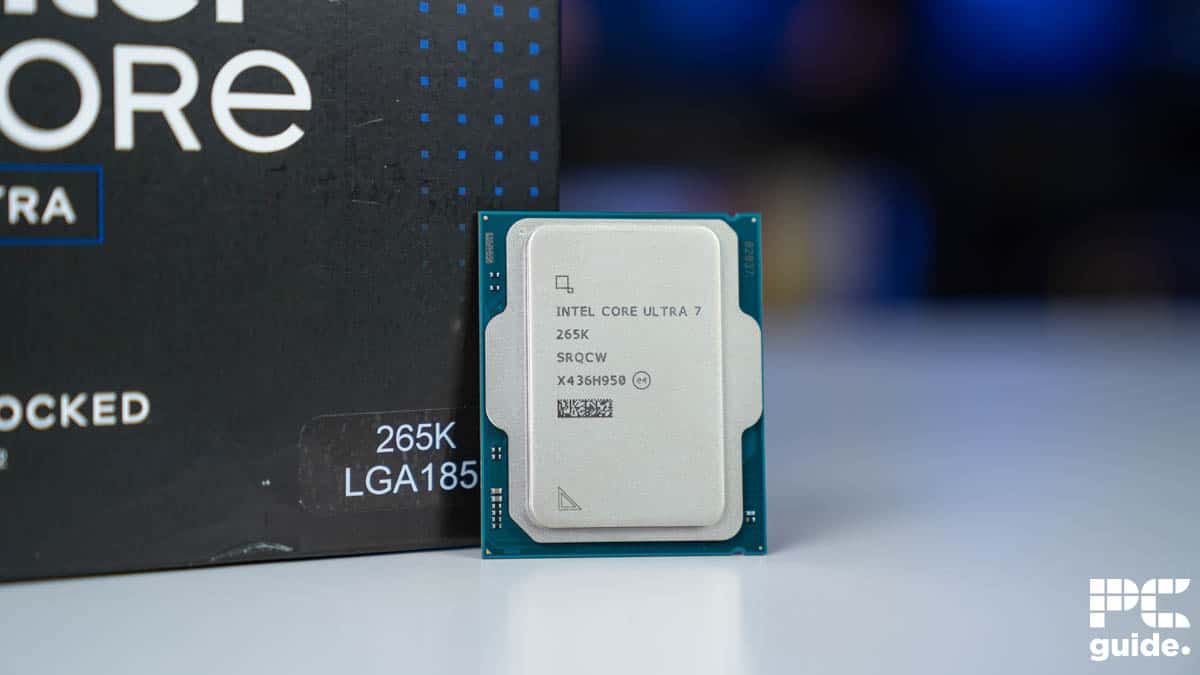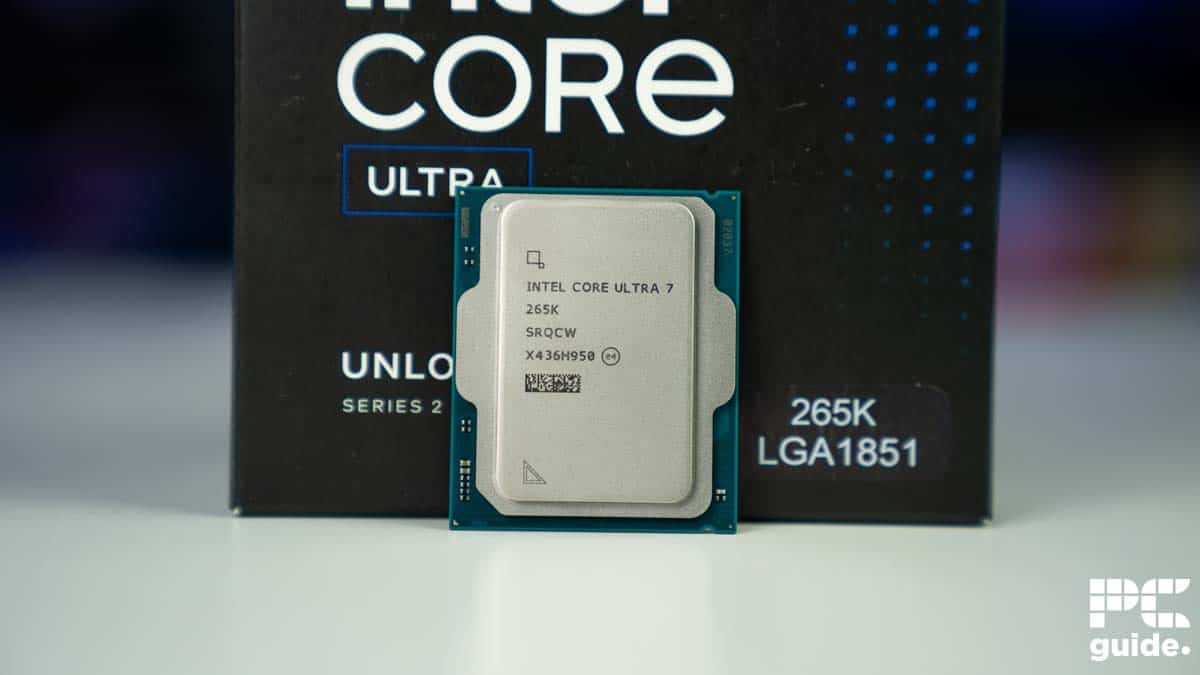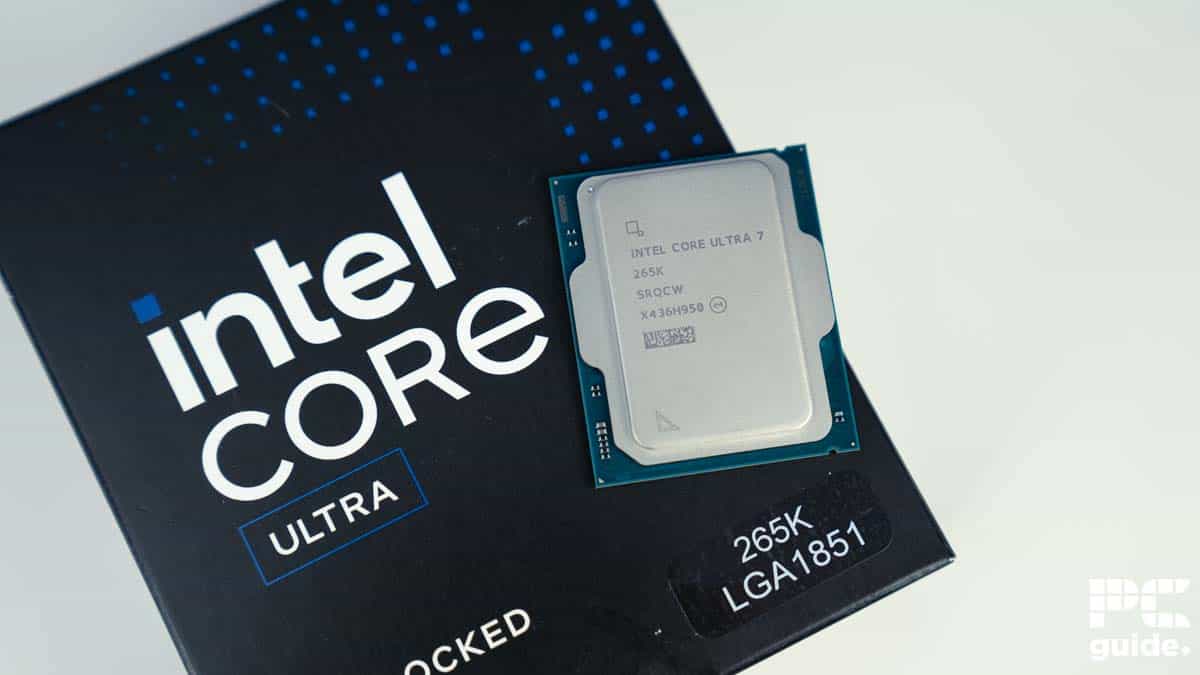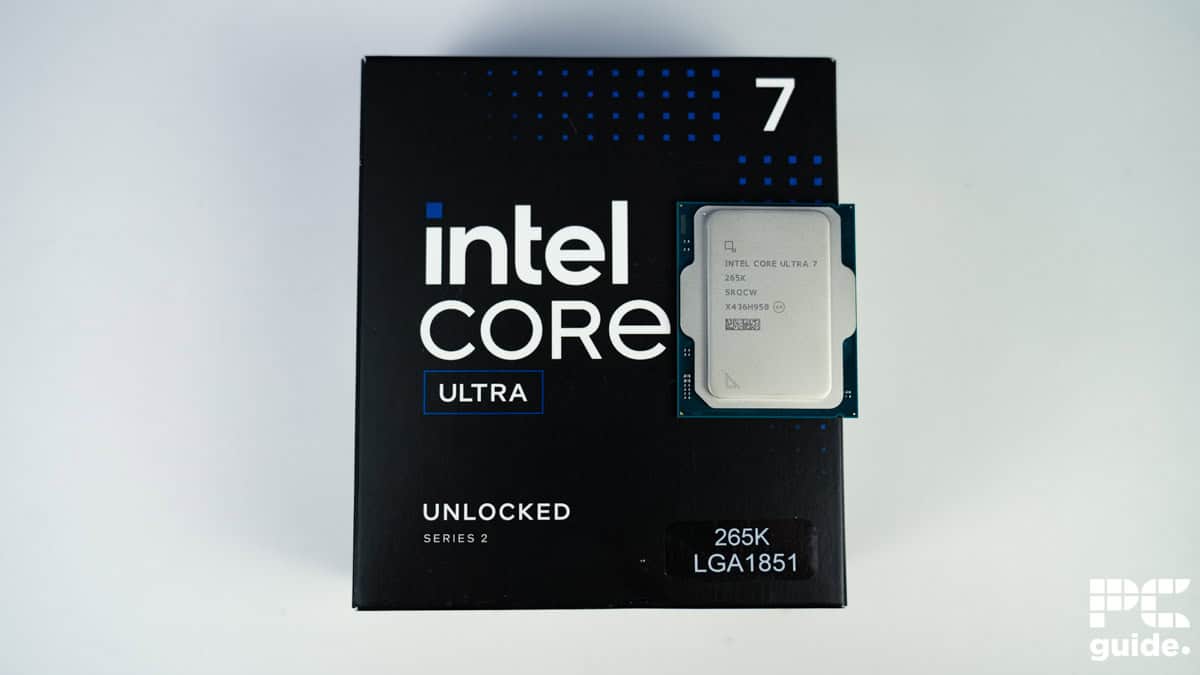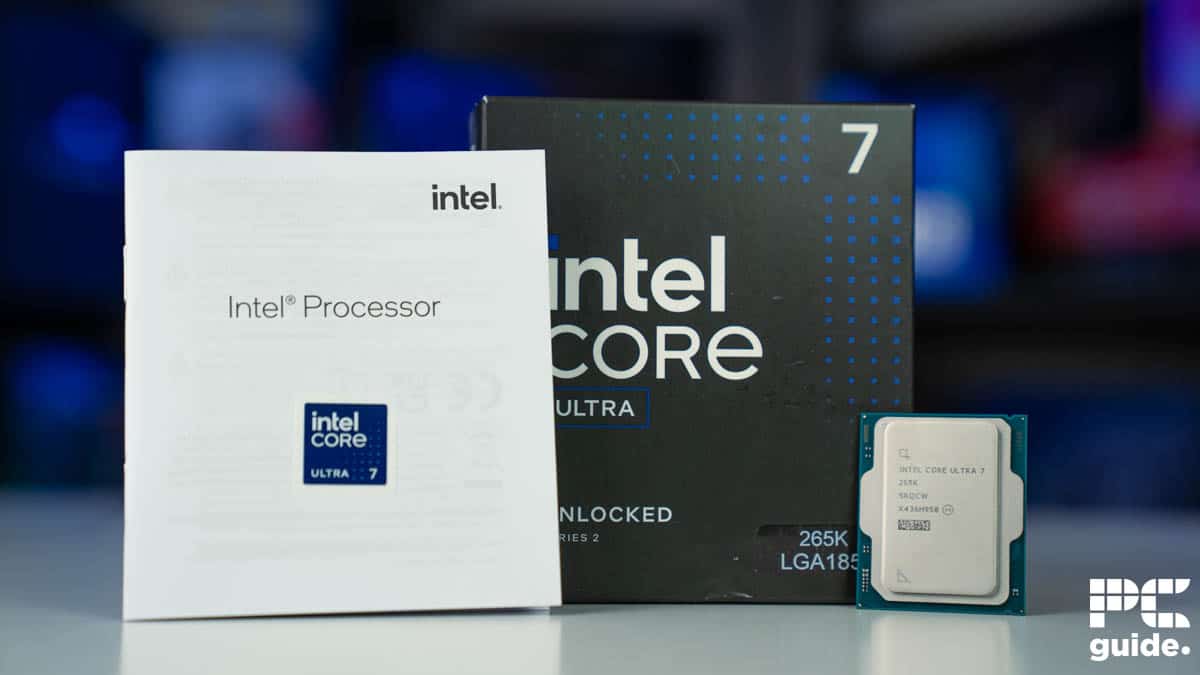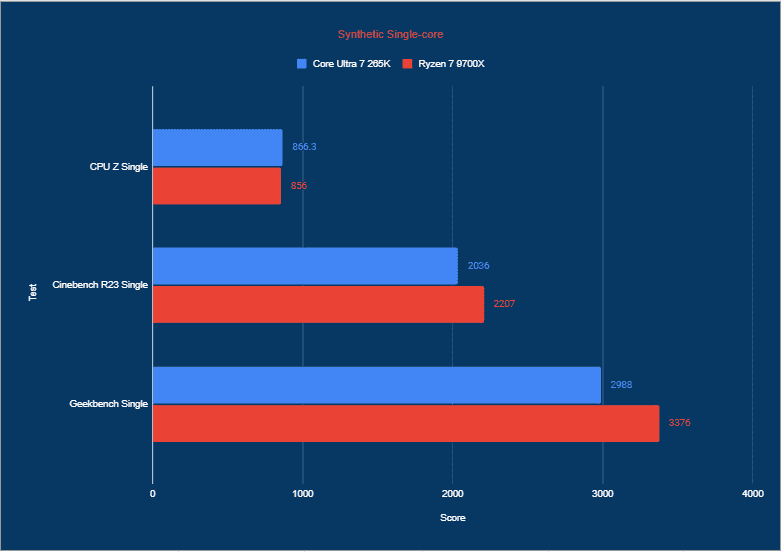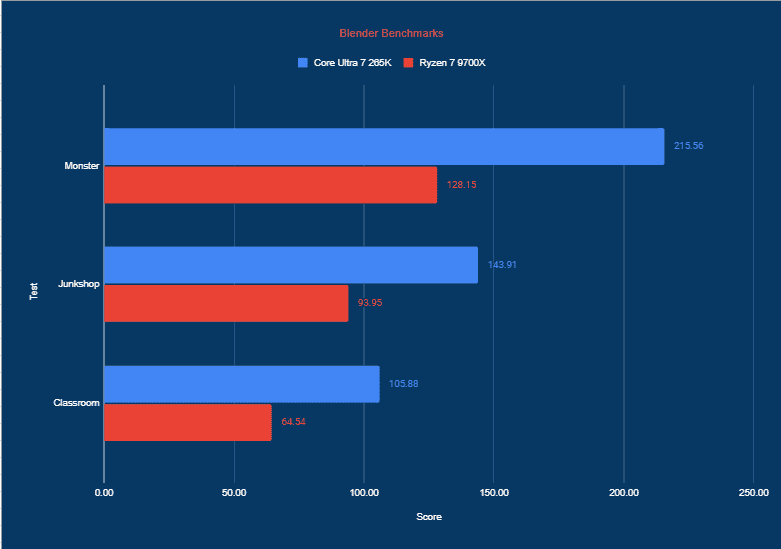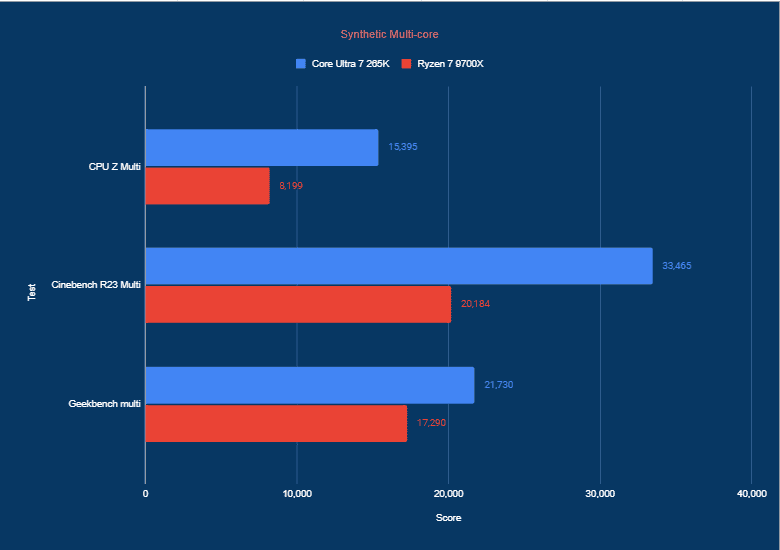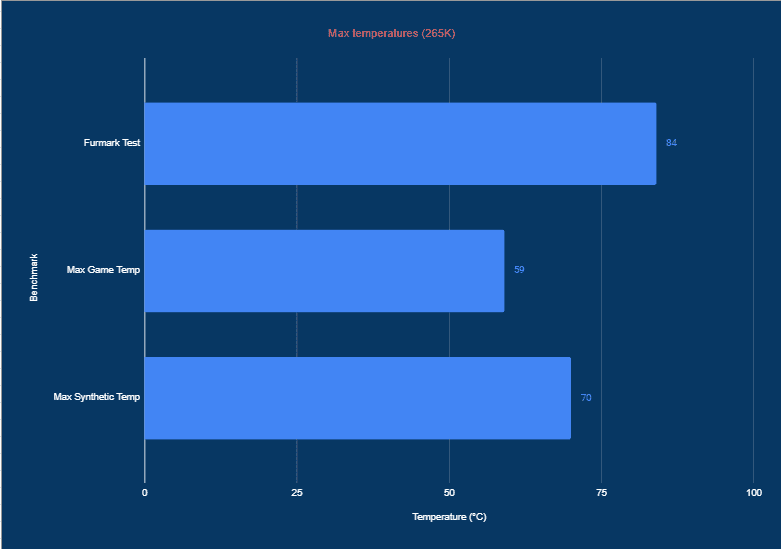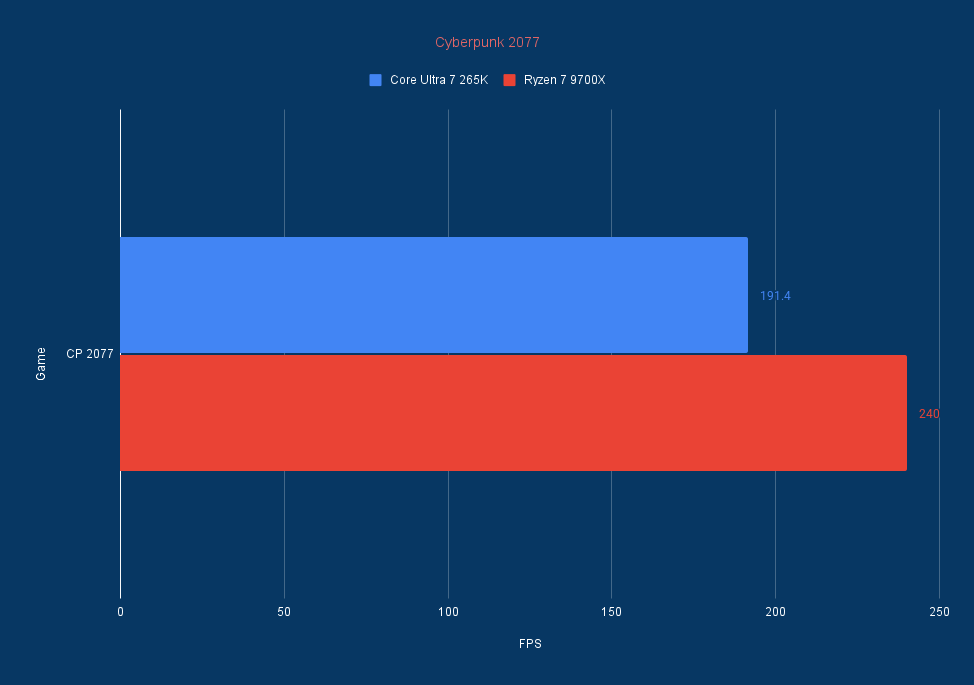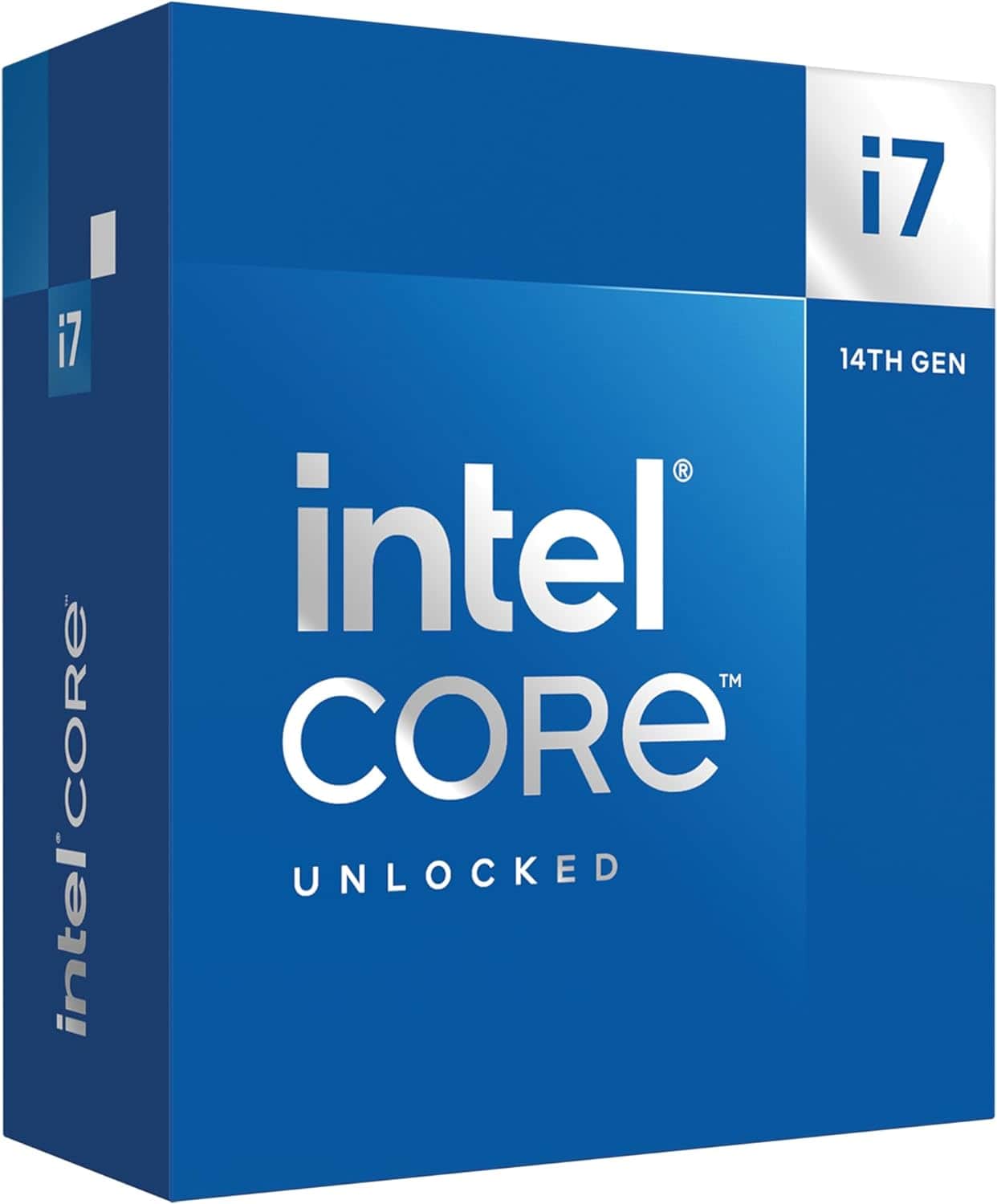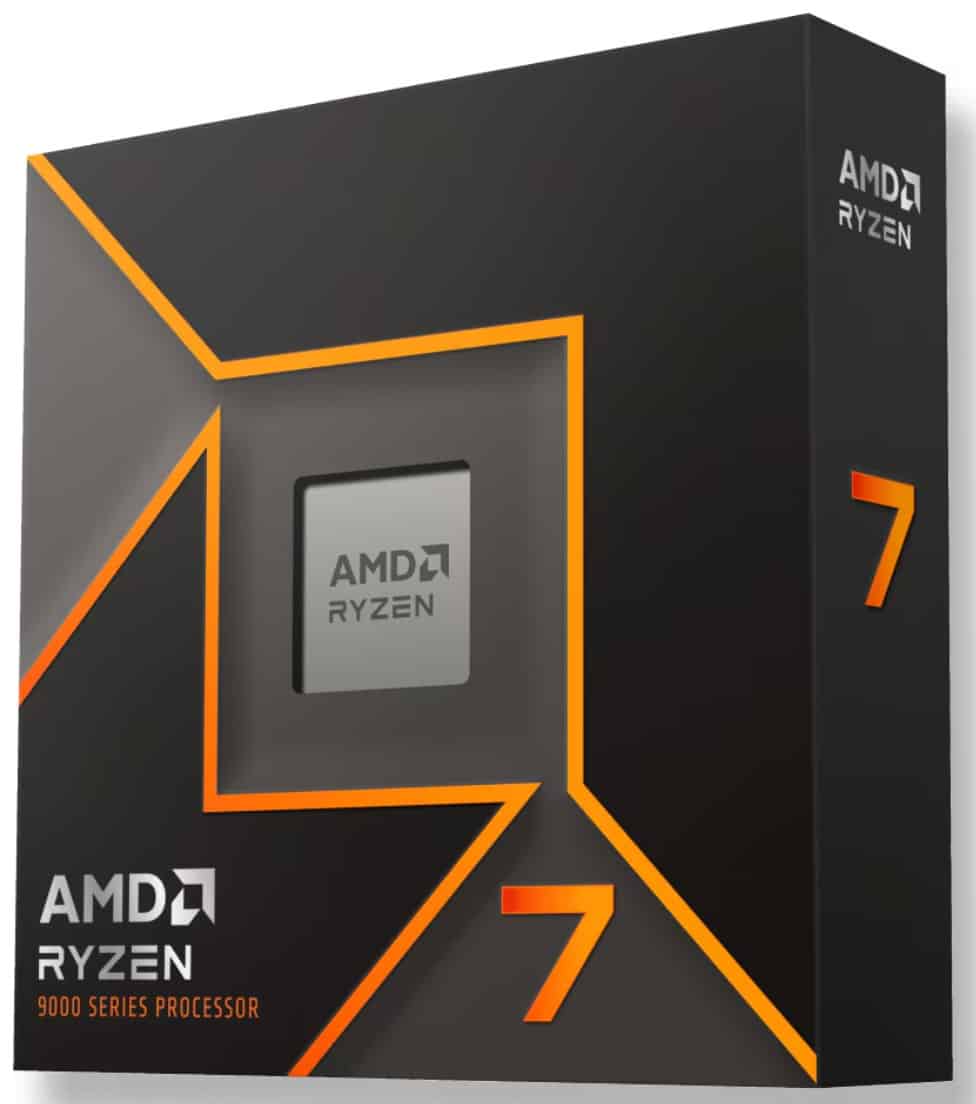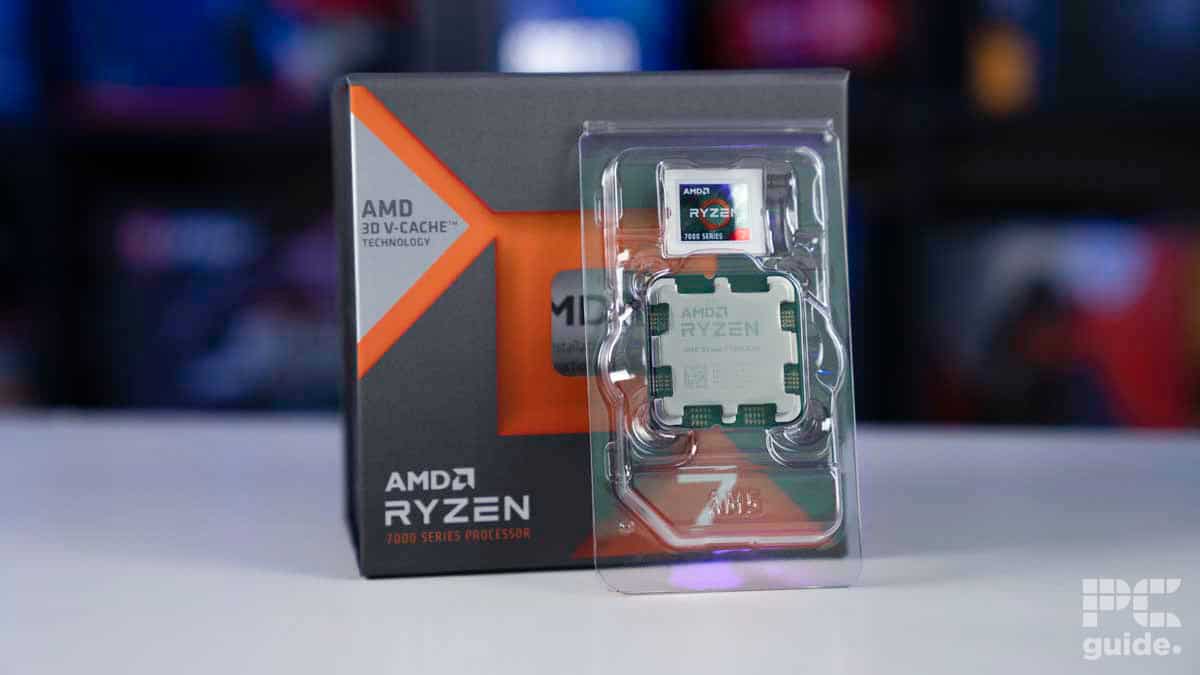Intel Core Ultra 7 265K review: mid of the pack, mid performance
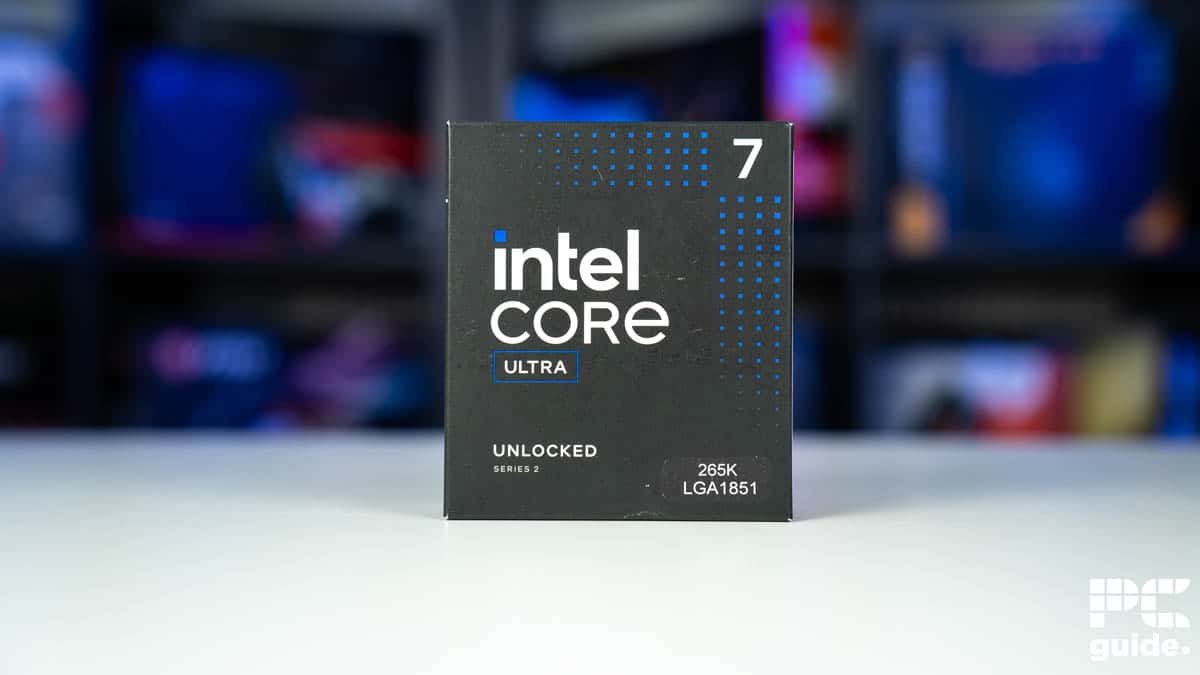
Table of Contents
The last of our initial reviews into Intel’s Arrow Lake processors is here, and after testing both the top and lower-end options, we’re now seeing how Intel’s middle-tier processor stacks up. Previously what would have been the i7 SKU, now drops the ‘i’ and restarts the count on the generation naming. Here’s how the Intel Core Ultra 7 265K performs, and ultimately whether it’s the right CPU for you.
- Cores: 20 (8P/12E)
- Threads: 20
- Boost clock speed: 5.5GHz
- Base clock speed: 3.9GHz P-core/3.3GHz E-core
- L3 cache: 30MB
- TDP: 125W base/250W max
- Platform: LGA 1851 (Arrow Lake)
While the Intel Core Ultra 7 265K doesn’t suffer the same performance-hindering issues as the other CPUs that fill the Ultra 200 lineup, it still isn’t a desirable chip when compared against the market’s alternatives. At a stretch, you could warrant its purchase if you’re looking for an all-around gaming/productivity machine – but there are caveats to that too.
For me, you’re far better off with the 9900X – which currently sets you back around $30 – $50 more. This chip will deliver similar synthetic workload performance as the 265K, while offering far better gaming performance.
- Strong multi-core performance against 9700X
- More cost effective for Multi-threaded workloads
- Very efficient next to 14th generation
- Pretty much on par with the 9900X (multi-core performance)
- Gaming performance leaves much to be desired
- No generational improvement in many scenarios such as gaming
- LGA 1851 motherboards are expensive
Specifications
| Spec | Core Ultra 5 265K | Core i7-14700K |
|---|---|---|
| Cores (Performance/Efficient) | 20(8/12) | 20(8/12) |
| Total threads | 20 | 28 |
| Max turbo/Base P&E Frequency | 5.4GHz P-core, 4.6GHz E-core/ 3.9GHz P-core, 3.3GHz E-core | 5.5GHz P-core, 4.3GHz E-core/ 3.4GHz P-core, 2.5GHz E-core |
| Intel Smart Cache/L2 | 30MB/36MB | 33MB/28MB |
| Base Power/Max Turbo power | 125W/250W | 125W/253W |
| Lithography | TSMC 3nm | Intel 10nm |
| Socket | FC LGA 1851 | FC LGA 1700 |
| Launch date | Q4’24 | Q4’23 |
| Launch price | $394.00-$404.00 | $409.00-$419.00 |
Comparing the 265K specs against its predecessor, the 14700K, we get to see the kind of changes that Intel has brought with its new generation. In fact, it’s a rather big reset on the basis of its production process and general features. Intel has gone to its competition in fab production, taking silicon from TSMC for this generation. This brings quite the upgrade to the spec considering Intel’s been stuck on 10nm for quite a long time, and shrinking down to 3nm is certainly an improvement.
Prime Day is finally here! Find all the biggest tech and PC deals below.
- Sapphire 11348-03-20G Pulse AMD Radeon™ RX 9070 XT Was $779 Now $739
- AMD Ryzen 7 7800X3D 8-Core, 16-Thread Desktop Processor Was $449 Now $341
- ASUS RTX™ 5060 OC Edition Graphics Card Was $379 Now $339
- LG 77-Inch Class OLED evo AI 4K C5 Series Smart TV Was $3,696 Now $2,796
- Intel® Core™ i7-14700K New Gaming Desktop Was $320.99 Now $274
- Lexar 2TB NM1090 w/HeatSink SSD PCIe Gen5x4 NVMe M.2 Was $281.97 Now $214.98
- Apple Watch Series 10 GPS + Cellular 42mm case Smartwatch Was $499.99 Now $379.99
- ASUS ROG Strix G16 (2025) 16" FHD, RTX 5060 gaming laptop Was $1,499.99 Now $1,274.99
- Apple iPad mini (A17 Pro): Apple Intelligence Was $499.99 Now $379.99
*Prices and savings subject to change. Click through to get the current prices.
This allows the chip to fit a lot more transistors, or lessen the amount of space they take up, creating a better-performing processor even in the same size. Although the Arrow Lake processors have changed socket type and size, cutting any compatibility with older motherboards, at least older coolers are still usable. But you might not need as mighty big AIO to keep temperatures down as the shrinking in the process also helps with keeping the chip cooler and the lower power rating, although the 265K is not as big of a cutback in max turbo power as the 14700K.
Another big change is the cutback on hyper-threading. Removing this feature now means Intel’s cores can only work with one thread at a time. So it now also matches the number of cores and threads compared to previous generations, while still retaining the performance and efficiency split in them.
The cores also now run with a higher base frequency on both the performance and efficiency cores, and when it comes to the max boost, the performance is slightly behind while the efficiency ones do reach a higher speed. But that’s only by default, and you’ll likely be overclocking it to push it even further, especially with the thermal overhead available. There is an increase in L2 cache onboard even with the overall smart cache dropping by a few MB also.
Test setup and performance
| Component | Name |
| GPU | RTX 4070 Ti |
| Memory | Corsair Dominator Titanium 64GB DDR5 @ 6800MT/s |
| Motherboard | MSI MAG Z890 Tomahawk WiFi |
| CPU cooler | Corsair Elite LCD Capellix 360mm |
| Power supply | ASUS ROG Thor 1000W |
| Case | Cooler Master Masterframe |
Next up we tested the capabilities of the Core Ultra 7 265K, putting it through a range of tests to see how well it performs. Pairing it up with an RTX 4070 Ti GPU to give us a display output, but shouldn’t have too much input when it comes to CPU benchmarking.
Along with plenty of fast DDR5 memory to support it, although the platform can go much faster now, this is what I already had to handle. It also required a Z890 motherboard to run and fortunately, the AIO cooler was already compatible and didn’t need extra hardware. We have an arguably overpowered 1000W PSU for this setup, but this will mean it’s not a worry or limiting factor. You can find out more about our decision-making process with our setups via our how we test CPUs page.
Results and Graphs
Here are the results of our benchmarking with the 265K. For comparison, we pitted the 265K against the 9700X – AMD’s rival to this Arrow Lake CPU.
Synthetics
Overall, the Core Ultra 7 scored fairly well against the 9700X in synthetic workloads – but first, let’s talk about the single-core performance. In pretty much every synthetic scenario, the 9700X edges ahead of the newly-released 265K – and this is before the 105W TDP patch (meaning it’s doing so at nowhere near its peak performance). The 9700X scores 2,207 points in CB R23 single, whereas the 265K only manages 2,036 – quite the disparity. It’s a similar story in Geekbench, with the 265K bringing home 2,988 points, and the 9700X scoring 3,376. It seems the cores in the 265K just can’t keep up with those found in AMD’s mid-tier 9700X.
Multi-core performance fares much better for the 265K, as it has access to considerably more logical processors. In some cases (such as CPU-Z) the Core Ultra 7 almost manages to double the score of the 9700X. Again, this is a pre-105W TDP patch, so the 9700X is only running at 65W. The 285K also blows the 9700X out of the water in the CPU-Z multi benchmark, scoring 15,393, respectively.
Other tests also solidify the domination of AMD’s rival chip, as the Core Ultra 7 scores 33,465 in Cinebench R23 and 21,730 in Geekbench – against the 9700X’s 20,184 and 17,290. One thing is clear: the true core deficit is the 9700X’s undoing, it simply can’t match up to the 20 super-efficient cores that Intel’s 265K brings to the table.
Gaming
Gaming is another kettle of fish altogether. The 9700X (even in its limited capacity) flexes its gaming performance prowess over the 265K in Cyberpunk 2077. AMD’s offering puts down a solid 240 FPS average compared to the 265K’s 191 FPS average. This may not be the full picture, as a lot of other reviewers have shown strange results in Cyberpunk. But for now, the 9700X is the clear winner when it comes to gaming. Even if Intel had beaten the 9700X in gaming by a decent margin, the 9800X3D is on the horizon and will shred Intel in gaming workloads, regardless.
Temperatures and power
In our thermal testing (265K paired with a Corsair H150i Elite LCD XT), the 265K still managed to achieve temperatures in the 80s. Keep in mind, that was under a 100% usage all-core load – a load essentially unheard of under normal usage. The maximum temperature we observed was 84°C in the Furmark 2 CPU stress test, 59°C in Cyberpunk, and 70°C in synthetic tests. This is good going compared to the likes of the previous generation – as they not only consumed a lot of power but also got very hot. This shows that the new Intel CPUs are, as expected, more efficient and easier to cool.
Price
When it comes to pricing, the 265K is currently between $394 and $404 as per the Intel spec page, and at the time of writing is $404 on Amazon. That is similar to the 14700K that was released with a $409 price tag, although now it sits below $360 most of the time.
As for the competition, it is a lot more expensive than the Ryzen 7 9700X, as that had a launch price of $359 and also now is going for a fair bit less than that. I’d even argue that going for AMD could be the most cost-effective option, as the platform costs with DDR5 are not going to be a factor in deciding between them.
Alternatives to the 265K
If you’re looking for alternatives or similar processors to the 265K, here are a few of my suggestions. If it’s a similar tier of hardware or a bit of an upgrade for gaming here are the top picks.
-
Intel Core i7-14700K
- Cores: 20 (8P-12E)
- Threads: 28
- Boost clock speed: P-Core 5.5GHz / E-Core 4.3GHz
- Base clock speed: P-Core 2.5GHz / E-Core 3.4GHz
- L3 Cache: 33 MB
- TDP: 125W
-
AMD Ryzen 7 9700X
- Cores: 8
- Threads: 16
- Boost clock speed: 5.5 GHz
- Base clock speed: 3.8 GHz
- L3 Cache: 32 MB
- TDP: 65 W
-
AMD Ryzen 7 7800X3D
- Cores: 8
- Threads: 16
- Boost speed : up to 5 GHz
- Base speed: 4.2 GHz
- L3 Cache: 96 MB
- TDP: 120 W
Firstly you can look back to the previous generation, with the i7-14700K the equivalent from there. You’ll also be able to enjoy a cheaper price from the platform and chip, but you will be getting onto a dead-end platform, with not much upgradeability. So it depends on what you need it for and the expectation for longevity.
From AMD the 9700X is a strong equivalent, a more gaming-focused processor it comes in cheaper and with a lower TDP still. So if you do not need the productivity performance, that is a strong option too. But an even better one would be the 7800X3D, excelling at gaming capabilities with its 3D cache makes it the one to get, or with a bit of a wait you can get the 9800X3D on release not too long after the Core Ultra 200 release.
Conclusion
- Cores: 20 (8P/12E)
- Threads: 20
- Boost clock speed: 5.5GHz
- Base clock speed: 3.9GHz P-core/3.3GHz E-core
- L3 cache: 30MB
- TDP: 125W base/250W max
- Platform: LGA 1851 (Arrow Lake)
The Core Ultra 7 265K is certainly not the CPU to go for if you want to build a high-performance gaming rig, however, it does hold some value in the low-power multi-core performance workspace. That said, there’s not much of a generational improvement over the previous generation in terms of gaming or single-core performance.
An area where the 265K shines, as does the rest of the Arrow Lake lineup, is efficiency. Efficiency is up by 35% on the new E-cores that feature in Intel’s 15th generation, partly because they dropped hyperthreading. The huge drop from a 10 nm manufacturing process to a 3 nm process is massive. Say what you like about the gaming performance of the Core Ultra 200 series, they have made the necessary step to a more efficient future. While we can not recommend this CPU to you right now, we appreciate the achievement Intel has managed and look forward to the future of Core Ultra CPUs.

